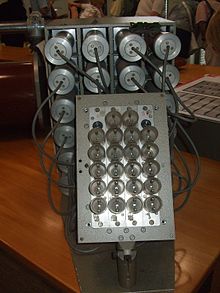Cranz-Schardin method
The Cranz-Schardin procedure , named after the ballistic experts Carl Cranz and Hubert Schardin , is used for the cinematographic recording of fast-moving processes. Using a so-called spark slow - motion camera (also called 24-spark camera ), which was developed by Cranz and Schardin in 1929, 24 images can be recorded at a frequency of up to five megahertz (MHz).
The peculiarity of the development of this process is that it was possible for the first time to take pictures separately on stationary film by means of the illumination with individual spatially distant sparks with this special camera. This enabled very fast dynamic processes such as B. the trajectory of a projectile can be tracked. The spark timing camera is still in use today.
functionality
The pioneers among the Cranz-Schardin cameras used a spark gap to expose the object. A spark slow motion consists on the one hand of a spark head, from which 24 sparks are ignited and serve as a light source, and on the other hand of a camera with 24 lenses , in which the objects are matched to the light rays; The spark head and camera face each other. The light beam from the spark is bundled on a lens in such a way that it is precisely focused into the camera after it has penetrated the object. The ignition of the sparks, which happens very quickly, takes place at different times, with each spark producing an image. This gives you a series of 24 photos .
Pulsed lasers are used in modern cameras that work according to the Cranz-Schardin principle . Lasers enable exposure energies that are significantly higher than that of a spark gap. The exposure time is only a few nanoseconds . The image distance can be reduced as required using optical switches, which in the simplest case consist of light guides of different lengths. So far, 10 ns to 25 ns image spacing has been considered practical. The camera itself consists of up to ten individual CCD sensors .
The Cranz-Schardin principle is still used today for the construction of high-speed cameras. The achievable image spacing leads to effective image frequencies around 100 MHz [see work by Lindau and Lauterborn] using the full resolution of the CCD chip (no binning required), which is hardly possible with purely electronic high-speed cameras. The very short exposure time enables razor-sharp images. Digital Cranz-Schardin cameras are primarily used in fluid mechanics (unsteady supersonic flows ) and for the visualization of fracture processes.
Web links
- Frank K. Lu, Xijing Liu: Optical design of Cranz-Schardin cameras , University of Texas at Arlington
- Contribution to www.filmarchive
- Spark slow motion principle with illustration (University of Würzburg)
proof
- C. Skupsch, H. Chaves, C. Brücker: Cranz-Schardin camera with a large working distance for the observation of small scale high-speed flows . In: Review of Scientific Instruments . tape 82 , no. 8 , August 17, 2011, p. 083705-6 , doi : 10.1063 / 1.3624692 .
- Olgert Lindau, Werner Lauterborn: Cinematographic observation of the collapse and rebound of a laser-produced cavitation bubble near a wall . In: Journal of Fluid Mechanics . tape 479 , 2003, p. 327-348 , doi : 10.1017 / S0022112002003695 .
- J. Holzfuss: Analog and Digital High Speed Cinematography - a Review . In: tm - technical measurement . tape 68 , no. 11 , November 2001, p. 499 , doi : 10.1524 / teme.2001.68.11.499 ( PDF Online ).
- H. Maecker: About the movement of impacted bodies . In: The natural sciences . tape 40 , no. 20 , 1953, pp. 521-522 , doi : 10.1007 / BF00628920 .

